Vintage Treasures: This Immortal by Roger Zelazny
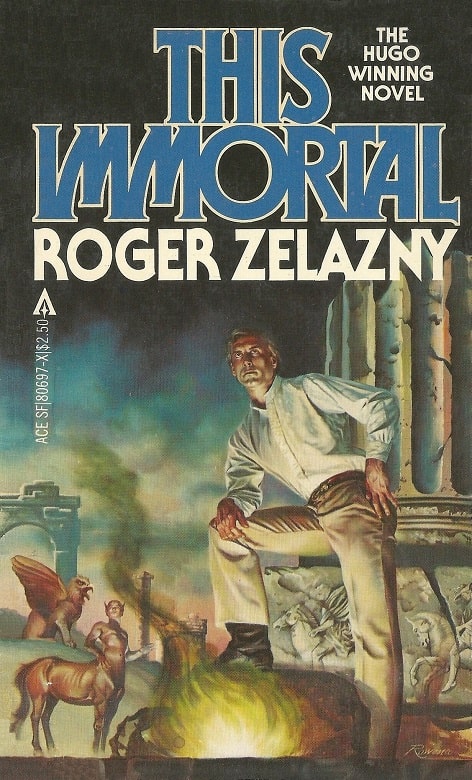 |
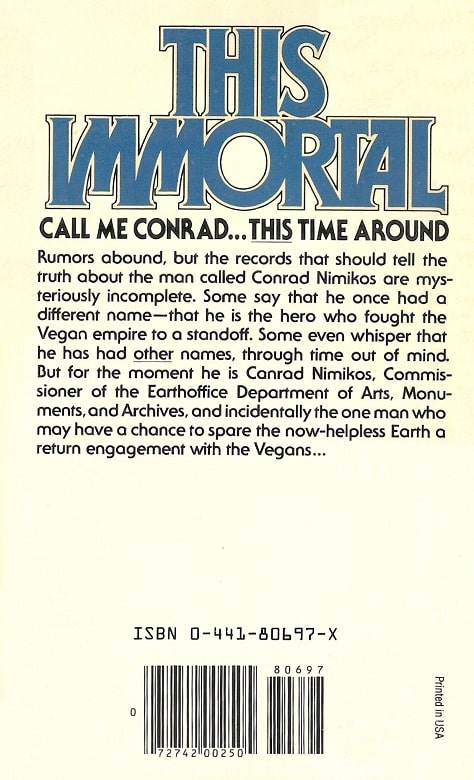 |
This Immortal (Ace Books, September 1980). Cover by Rowena Morrill
Two weeks ago I dashed off a Vintage Treasures piece on Larry Niven’s first collection Neutron Star, the first I’d ever done on Niven, and it helped me realize that there are several other major writers sorely underrepresented in these pages. Near the top of that list is Roger Zelazny, one of the most important fantasists of the 20th Century, and the man behind much of the work that turned me into a lifelong science fiction reader.
So today I’d like to talk about This Immortal, Zelazny’s first novel, published as a paperback original in July 1966 by Ace Books. It was the work that cemented Zelazny’s reputation as one of the finest genre writers of his generation, and it tied with perhaps the most famous science novel of all time — Frank Herbert’s Dune — for SF’s highest honor, the Hugo Award for Best Novel.
The Magazine of Fantasy and Science Fiction, October 1965, containing the
first half of Roger Zelazny’s “… And Call Me Conrad.” Cover by Chesley Bonestell
By 1966 Zelazny already had a stellar reputation for his short fiction, with classics such as “A Rose for Ecclesiastes” (Hugo nominee, 1963) and the Nebula Award-winning “He Who Shapes” and “The Doors of His Face, the Lamps of His Mouth” (both 1965) under his belt. This Immortal was published in two parts in The Magazine of Fantasy and Science Fiction (the October and November 1965 issues), in a version that was heavily edited by the editor.
How heavily edited was the magazine version, and how much was restored for the later paperback editions? That’s a little complicated by the fact that the first paperback edition was still incomplete and that the magazine version, although shorter, includes some text that did not survive future revisions. Wikipedia has the most concise summation I’ve found to date.
Most, but not all of the edits made for the serialized version were restored for the first paperback publication by Ace Books [July 1966]] and the title was changed by the publisher to This Immortal… The abridged version was novel length at over 47,000 words; the paperback version was over 58,000 words after the cuts were restored. However, it was not until a book club version was published in the 1980s that Zelazny realized that some cuts had not been restored to the book version; thus, earlier publications of This Immortal were still not complete.
The abridged magazine version also contains 10 paragraphs of text not in the book version, starting from “And the long-dormant Radpol was stirring again, but I did not know that until several days later” and ending with “The days of Karaghiosis had passed.” Also, the “Synopsis of Part One” that appeared in the November 1965 issue of F&SF (immediately prior to Part Two) is written in the first person and contains material about Conrad’s character and backstory that is not in the main text of …And Call Me Conrad” nor the 1980s restored version of This Immortal.
In general the versions to read are the 1980 Ace edition (at top) for completeness, and for collectors, the original magazine version, to get the addition text excised from all the paperback editions.
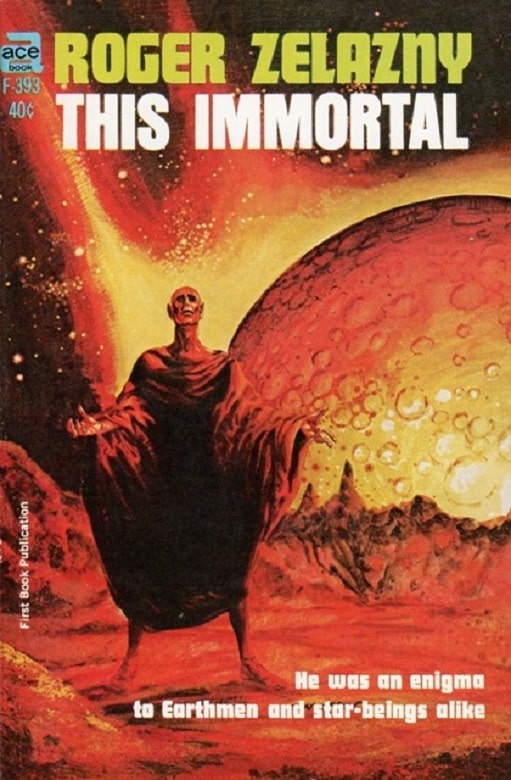 |
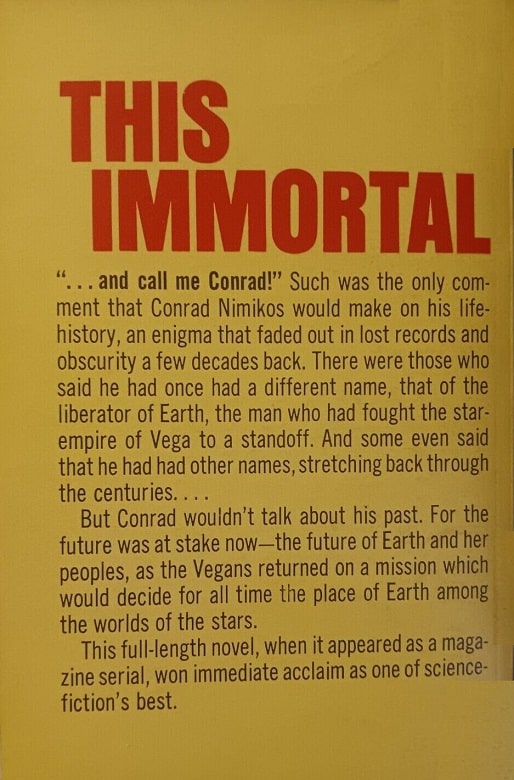 |
This Immortal paperback first edition (Ace, July 1966). Cover by Gray Morrow
In a 2009 review of the book in The Guardian (how many science fiction novels get a feature review in a global newspaper 44 years after publication?) Sam Jordison puts the scene in perspective.
In 1966 (or so I’ve been told), Roger Zelazny seemed like the future of science fiction. He was one of a progressive breed of SF writers who came to be known as “the new wave” in homage to the French film directors who were said to have influenced them. These authors were generally characterised by a determination to move the genre away from its pulpy origins, to tackle difficult political issues and use sophisticated literary devices to do so.
Typical to SF sub-genres, there are all kinds of complexities, arguments and disqualifying criteria relating to the new wave, but the point, as far as this blog is concerned, is that after publishing a series of pioneering short stories, Zelazny was generally regarded as hot, hip and bang up to date…
It’s set on a future Earth, some years after a near-apocalyptic nuclear war. Most of the mainland has been destroyed, but life still continues on islands – albeit complicated by the presence of various mutants (mainly based on mythological creatures) who have grown up around radiation hotspots, and by a race of blue aliens – the Vegans – who seem intent on buying up the Earth as real estate. The narrator is a superhuman of considerable (but unspecified) age who likes to be called Conrad, but seems to have many other names. He was once a revolutionary determined to blow up everything to do with the Vegans and Earth-folk who live “off-planet,” but who now acts as a kind of caretaker of Earth’s remaining historical sites and ends up fighting to protect a Vegan called Myshtigo from a superhuman assassin in the pay of a group inspired by his own revolutionary past …
Zelazny cleverly builds intrigue around [his characters] using determinedly vague allusions to their long histories, odd powers, and convoluted love lives. I didn’t believe in Conrad, or like him, but I did start to find him fascinating. There is also plenty of strange and beautiful writing about the Vegans and their different perceptions… Zelazny’s future world, where mutant humans, blue aliens, mythological creatures and supermen collide, also allows him to build some joyously over-the-top scenarios. The climactic showdown has to be one of the most absurd in literature. Think One Million Years BC, crossed with Dracula, Heart of Darkness (complete with learned Kurtz references), Gladiator and the Texas Chainsaw Massacre and you’re on the way to encompassing its lurid weirdness.
Jordison is critical (not without reason) of Zelazny’s “no-longer-achingly-hip narrative voice.” As you’ll note in the reviews below by Rich Horton and Jo Walton, other reviewers appreciated that the “dialogue crackles throughout,” and the protagonist is a “smartass hero, wisecracking his way across the adventure.” It’s all a matter of taste, I suppose.
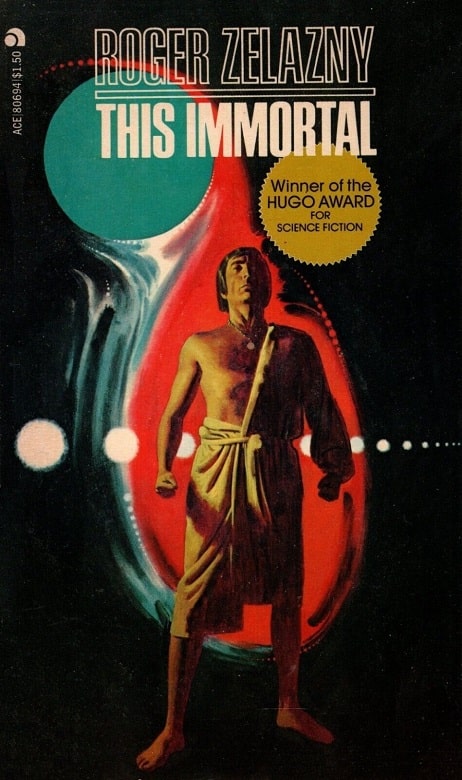 |
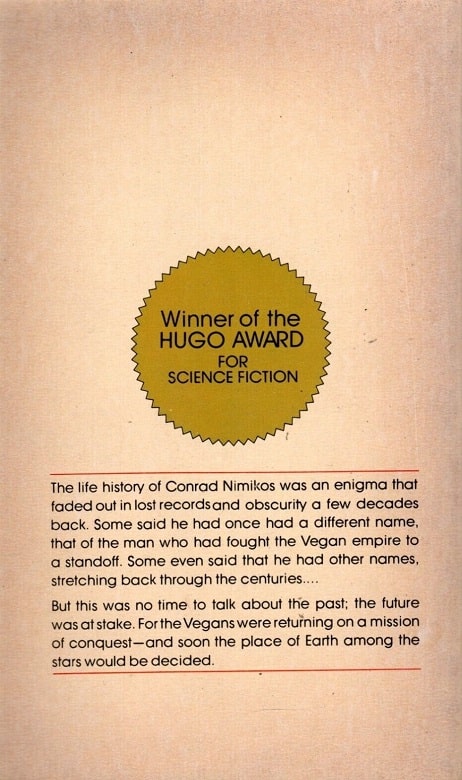 |
This Immortal (Ace, April, 1973). Cover artist uncredited
Rich Horton wrote, to my mind, a much more on-point review for me, in the very early days of the SF Site website. Here’s an excerpt.
This Immortal is a good read, with plenty of Zelaznyesque brio… The storyline concerns Conrad Nomikos, one of about 4 million people still living on Earth centuries in the future, after a nuclear war, and after the bulk of the population has gone to the stars to work for the advanced, civilized Vegans. Conrad and some of his friends had years before been involved in the “Returnist” movement, urging people to return to Earth, and resisting the Vegans’ moves to buy up the best Earth real estate. Nowadays, the situation is a stalemate, with Earth’s exile population preferring not to return, but with the Vegans not buying any more of Earth either.
But Cort Mishtigo, a high status Vegan, has come to Earth to tour some of the ancient sites. Conrad, who seems to have some mysterious past identities that go back a long way, is recruited to guide Mishtigo, and to protect him from assassins. He is in danger because the more radical Returnists believe that his “tour” is a pretext for evaluating more real estate, in advance of a renewed Vegan buying campaign. Conrad is unsure of Cort’s motives, and anyway unhappy with the idea of murder. The novel consists, then, of Cort’s tour, and a number of well-done battles between Conrad and a variety of monsters and mutants. The fight scenes, and the descriptions of the mutants (based on Greek mythology), are really good…
This is great fun to read, and very skilled and clever. Conrad is a fairly standard Zelazny hero, wisecracking and self-deprecating. The dialogue crackles throughout, and the other characters are nicely limned. Conrad’s dilemma is believable: the conflict between his professional desire to protect his client (along with his personal distaste for murder) and his loyalties to Earth and the Returnists against the Vegan domination of Earth is well handled. And the various set-pieces and fight scenes are exciting and original. And the ultimate message of the book, about proper stewardship of our planet, and who deserves to be stewards, is clearly seen, and resolved with irony and honesty. It’s good to have this book in print again.
Jo Walton had a delightful review series in the early days of Tor.com, looking at the best science fiction of her youth. Here’s here take on This Immortal titled, appropriately enough, “Wisecracking, aliens, and hot places.”
This Immortal, or “And Call Me Conrad” was Roger Zelazny’s first novel, and it showcases a lot of the things that he typically did. It’s unquestionably science fiction, but it uses mythic resonance in a way more familiar in fantasy. It has a first person smartass hero, wisecracking his way across the adventure. It’s fast moving and builds the world up as a neat piece of juggling — and of course, it’s poetic and beautifully written. I can see some people hating Zelazny for the very things I love about him — the style, the prose, the offhand worldbuilding. It doesn’t always work for me. But when it does, as here, it’s lovely.
In This Immortal it’s Greek mythology, and Greek folktales too. In the first line, Conrad is accused by his wife Cassandra (who is, naturally, always right and never believed) of being a kallikanzaros — one of the demons who try to destroy the world and are scared away by the Easter bells. He’s tall and hairy with one leg shorter than the other and he somehow just doesn’t seem to age. This is because there was a nuclear war on Earth, the “Three Days” and there are a whole lot of mutants around, especially near the “hot places” that are still radioactive. There are also a whole lot of alien tourists, and Conrad’s job involves taking one of them on a tour of beautiful but devastated Earth, while other people, human, mutant, and alien, seem desperate to kill him…
What we have here is a picaresque in the traditional old fashioned sense — the characters go from place to place and encounter and overcome dangers while we learn about them and about the world. Zelazny gives us enough of all three things — the encounters, the characters and the world — to keep us fascinated and tantalised… There are moments in this book that are as good as anything Zelazny ever wrote — getting a telepathic flash of being in the alien’s mind and seeing ultra-violet colours in a white flower, fighting a boadile and wondering how many legs it has, Hasan saying the devil has forgiven him.
Read Jo’s complete review here.
The Collected Stories of Roger Zelazny, Volumes 1 – 6 (NESFA Press, 2009). Covers by Michael Whelan
You can call me biased, but my favorite piece about This Immortal can be found closer to home, right here at Black Gate. Here’s James Enge from his review of Volumes One and Two of the monumental The Collected Stories of Roger Zelazny, which includes the magazine version, “… And Call Me Conrad.”
Who was the greatest American fantasist of the 20th century? People will have their own notions about this (as opposed to the greatest British fantasist of the 20th century, where most lists will begin with Tolkien). Personally, I think Fritz Leiber is several of the century’s greatest fantasists, and other obvious candidates would include Robert E. Howard, Kuttner and Moore, Leigh Brackett, Jack Vance, Ursula Le Guin. John Crowley has his advocates; no doubt there are others. One name I always think of in this connection is Roger Zelazny…
Almost no one had heard of Zelazny before 1962. A few years later he was an acknowledged giant in the sf/f field. By end of the decade people were saying he was on the skids. De gustibus non disputandum. In my view (and many others) few fantasists will ever reach the heights Zelazny achieved in his later period…
In his early award-winners “A Rose for Ecclesiastes” and “The Doors of His Face, the Lamps of His Mouth,” the ideas Zelazny is playing with include Brackett-style space opera, Hemingwayesque notions of masculinity, the ironic use of sacred text, miscegnation, and fish. I left out a few for brevity’s sake… The biggest eye-openers for me in either volume were the early Dilvish stories… both as examples of Zelazny’s restless experimentation and as deftly (and concisely) written pieces of adventure fantasy…
Even in his brief apprenticeship Zelazny was writing better than most people ever will, and he was learning to make up his own myths, as well as steal other peoples’ more skillfully. In “For a Breath I Tarry,” the book of Job meets the second chapter of Genesis, with introductions performed by Mephistopheles, in a post-apocalyptic world empty of and haunted by humanity (see Bradbury’s “There Will Come Soft Rains.”)
And the narrator of “…And Call me Conrad” may be Pan, but it’s not all-important if he’s not; it matters far more that Conrad Nomikos is a monster-hero who destroys and protects things and people unpredictably. (“Feathers or lead?”) One of the editors’ more interesting choices was to include the magazine version of “…And Call me Conrad,” the version for which Zelazny won the Hugo (and which differs significantly from the book publication, mostly because of the space requirements of F&SF).
This Immortal was published by Ace Books in July of 1966. It is 174 pages, priced at 40 cents. The cover is by Gray Morrow. It was reissued by Ace with new covers several times over the next fourteen years:
First Ace printing: July, 1966 — 40 cents cover price, cover by Gray Morrow
Second Ace printing: May, 1970 — 40 cents cover price, cover by Gray Morrow
Third Ace printing: April, 1973 — 95 cents cover price, cover artist unknown
Fourth Ace printing: September 1980 — $2.35 cover price, cover by Rowena Morrill
The novel is still in print (in the edited magazine version) in Volume Two of The Collected Stories of Roger Zelazny, and in digital formats.
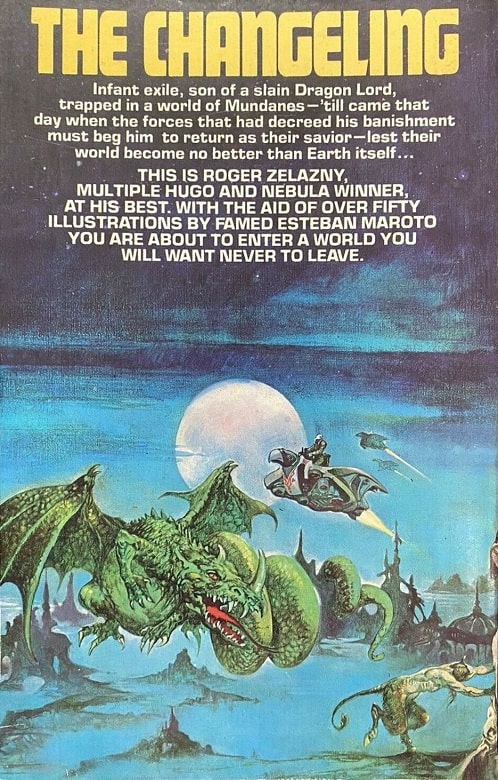 |
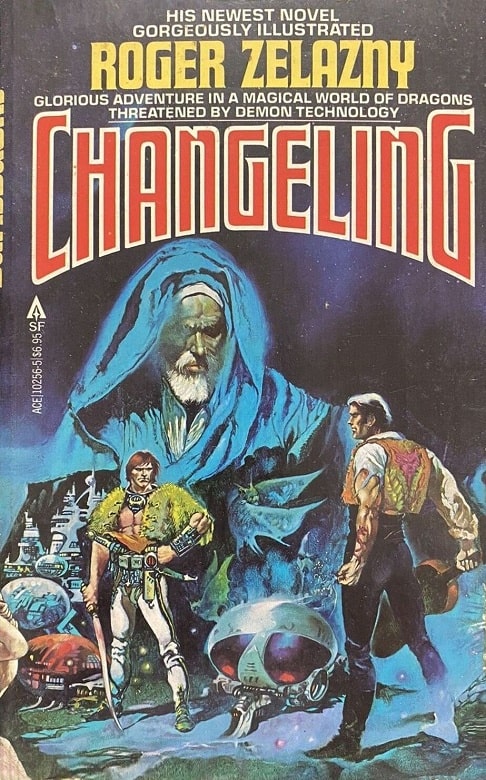 |
Changeling by Roger Zelazny (Ace Books, June 1980). Cover by Esteban Maroto
Our previous coverage of Roger Zelazny includes:
On the Other Hand–Amen: The Collected Stories of Roger Zelazny. Volume One: Threshold; Volume Two: Power and Light by James Enge (2009)
A Review of Changeling by Isabel Pelech (2011)
Roger Zelazny, August Derleth and Appendix N: Advanced Readings in D&D (2013)
Vintage Treasures: Damnation Alley (2015)
Cloud Sculptors, Dragon Riders, and an Unearthly Craps Game: Nebula Award Stories 3, edited by Roger Zelazny by William I. Lengeman III (2015)
Steven Brust’s Five Roger Zelazny Books That Changed His Life (2017)
Dilvish, The Damned by Fletcher Vredenburgh (2017)
Vintage Treasures: Four For Tomorrow (2018)
The Golden Age of Science Fiction: “The Last Defender of Camelot” by Steven H Silver (2019)
Skybound Moves Forward With Roger Zelazny’s Chronicles of Amber (2023)
See all our recent Vintage Treasures here.
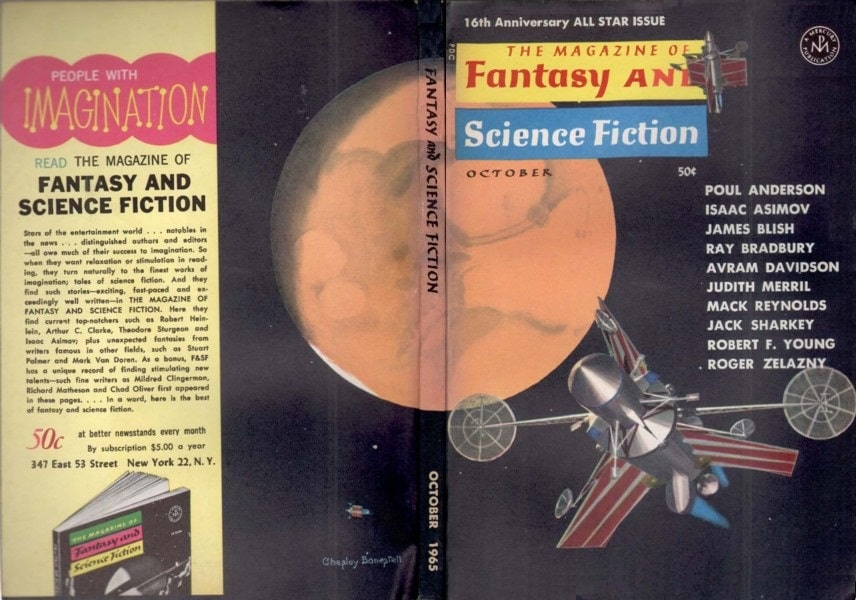
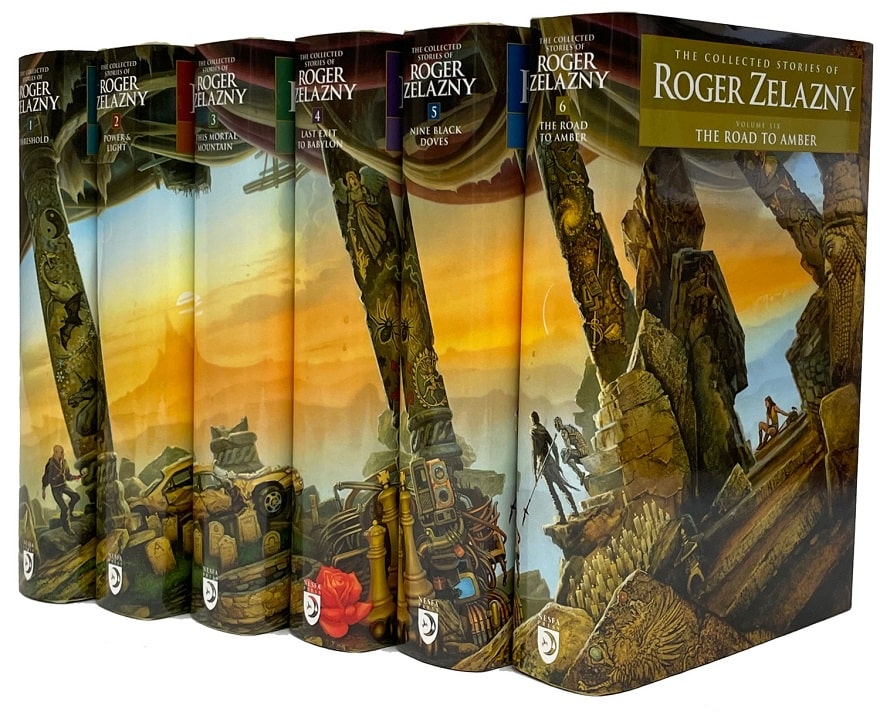
Great NESFA editions; out of curiosity, has anyone at Black Gate written an article about the output of NESFA Press? I think it would make fascinating reading.
Hi Lou,
Great suggestion! And no, we haven’t done anything like an overview of their incredible output, but over the years we’ve mentioned our fair share of their releases, such as THE COLLECTED SHORT WORKS OF POUL ANDERSON
https://www.blackgate.com/2017/06/11/the-collected-short-works-of-poul-anderson/
Cyril Kornbluth’s magnificent His Share of Glory
https://www.blackgate.com/2009/04/22/the-good-the-brown-and-the-kornbluth/
Fredric Brown’s fabulous From These Ashes
https://www.blackgate.com/2013/11/04/vintage-treasures-the-best-of-fredric-brown/
John Bellairs’ Magic Mirrors
https://www.blackgate.com/2010/08/08/faces-in-the-mirror/
And Rich Horton (of course) looked at several at the bottom of this article:
https://www.blackgate.com/feature-excerpt-back-to-the-future-modern-reprints-of-classic-fantasy/
This was the first story by Roger Zelazny that I ever read (I had the July 1966 paperback until it fell apart after being read by three generations of my family) and it left a mark. I prefer it to Dune and currently have the SFBC version but I did not know there was additional material in the magazine version. Many thanks for pointing me at it and for a great post!
Glad to be of service, John!
I don’t know how essential the additional material in the mag version is. To be honest, I’m mostly very curious about the additional info in the recap for Part 2. I assume Zelazny crafted that for F&SF.
I read this for the first time several years back and liked it fine, but it comes in second to my favorite Zelazny, The Dream Master.
Thomas,
You know, I’ve never read The Dream Master, and I need to remedy that. In fact, the Universe won’t be in harmony until I cover a lot more Zelazny books as Vintage Treasures…. I might be able to kill two birds with one stone here.
The first novel by Zelazny I read and I really enjoyed it. (I had read a few of his short stories before.) I always thought of it as a post-apocalyptic retelling of Hercules’s labors in the voice of Philip Marlowe.
Zelazny is the pioneer of trying to “adapt Raymond Chandler style hard-boiled to fantasy and science fiction”. It does get repetitive over the entirety of his oeuvre, which may be why he is no longer held in the high regard that he deserves. But he did experiment with different variations of the high fantasy hard-boiled combination, so the protagonist could be the more light-hearted type in Doorways in the Sand or the truly evil bastard in Jack of Shadows.
If Zelazny’s narrative voice and style is now “no-longer-achingly-hip”, it’s because so many later writers have adopted it in their works. Glen Cook’s Garrett P.I. comes to mind. And the works of Elizabeth Bear that I’ve read (the Jacob’s Ladder and Lotus Kingdom trilogies) come very close to Zelazny’s style minus some of the more flashy “modern” literary techniques he tries on. In fact, my reaction to the recent book Witch King was that it was “Martha Wells channeling Elizabeth Bear channeling Roger Zelazny”.
Paul,
> Zelazny is the pioneer of trying to “adapt Raymond Chandler style
> hard-boiled to fantasy and science fiction”. It does get repetitive over
> the entirety of his oeuvre, which may be why he is no longer held
> in the high regard that he deserves.
I think that’s very astute. A big part of what drew me to Zelazny was his engaging narrative voice. But it’s been many years since I’ve read Zelazny books back-to-back.
> But he did experiment with different variations of the high fantasy
> hard-boiled combination, so the protagonist could be the more
> light-hearted type in Doorways in the Sand or the truly evil bastard
> in Jack of Shadows.
The first time I read Jack of Shadows I was seduced by the usual Zelazny-style narrator, and ultimately found the book very unsatisfying. It wasn’t until I read it as an adult that I realized that Jack is the villain — and a pretty awful one at that.
“I always thought of it as a post-apocalyptic retelling of Hercules’s labors in the voice of Philip Marlowe.”
Matthew,
That description is more on point that anything I wrote above. I wish I’d said it!
I have to say I still think “. . . And Call Me Conrad” was a better title.
William…. Hmm. I find it a little too twee and self-absorbed, but maybe that’s because I thought of this book using its published title for the first 20 years.
One of the Zelaznys I’ve not yet read; must do something about that.
Joe,
At least it’s short!
Let us know what you think if you do dig into it. 🙂
I haven’t read “Call Me Conrad”, but the subject of whether shorter pieces were improved or “disimproved” by expansion is an interesting one. (I think the shorter versions of Fredric Brown’s Martians Go Home and Robert Silverberg’s Haswkbill Station are superior to the novel versions, for instance.)
Thanks for the kind words and even more for this blast from the past. This Immortal remains one of my favorite Zelazny novels. It certainly has elicited a lot of strange covers over the years. The version I read to pieces as a kid had someone who looked like Anthony Quinn in a mutilated bathrobe that was probably meant to be a toga. Then there’s that even odder one by Rowena where Conrad looks like a Yuppie. Dennis Beauvais’ cover from the first Baen Edition (1989) might be the best–suggestive of the contents, but not trying to reshape Conrad into some kind of conventionally appealing figure.
I’d forgotten that the textual history of the novel was so complicated. I wonder which one Gary Wolfe used in the Library of America collection (American SF Novels of the 1960s)?
On a recent reread, I was struck by Zelazny’s penchant for respectful portraits of not-widely-understood religions: Santería, Coptic Christianity, and the worship of Malak Tawus. I thought Zelazny was making up Hasan’s religion, until a widely-travelled prof told me in grad school about the Yazidi religion.
Zelazny seems to have been interested in everything and made use of everything–a good model for anyone aspiring to write “philosophical romance shot through with elements of horror and morbidity”.
James,
I’m jealous of your frequent Zelazny rereads. My reading calendar is tightly planned weeks in advance to make sure I can cover the titles I want to write about for the next 2-3 months… re-reading of favorites is a luxury I can’t afford. Maybe in retirement!!